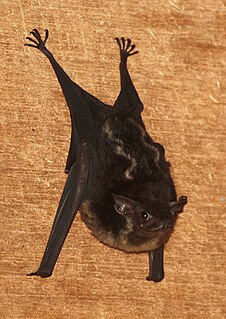
Microbats constitute the suborder Microchiroptera within the order Chiroptera (bats). Bats have long been differentiated into Megachiroptera (megabats) and Microchiroptera, based on their size, the use of echolocation by the Microchiroptera and other features; molecular evidence suggests a somewhat different subdivision, as the microbats have been shown to be a paraphyletic group.

Mammalia is a class of animal within the phylum Chordata. Mammal classification has been through several iterations since Carl Linnaeus initially defined the class. No classification system is universally accepted; McKenna & Bell (1997) and Wilson & Reader (2005) provide useful recent compendiums. Many earlier ideas from Linnaeus et al. have been completely abandoned by modern taxonomists, among these are the idea that bats are related to birds or that humans represent a group outside of other living things. Competing ideas about the relationships of mammal orders do persist and are currently in development. Most significantly in recent years, cladistic thinking has led to an effort to ensure that all taxonomic designations represent monophyletic groups. The field has also seen a recent surge in interest and modification due to the results of molecular phylogenetics.

Emballonuridae is a family of microbats, many of which are referred to as sac-winged or sheath-tailed bats. They are widely distributed in tropical and subtropical regions across the world.

The greater sac-winged bat is a bat of the family Emballonuridae native to Central and South America.

The northern ghost bat is a bat species from South America, Trinidad, and Central America. It is a relatively rare, completely white, insectivorous bat, with an unusual sac at the base of its tail.

The proboscis bat is a bat species from South and Central America. Other common names include Long-nosed proboscis bat, sharp-nosed bat, Brazilian long-nosed bat and river bat in English, and murciélago narizón in Spanish. It is monotypic within its genus.

The lesser sac-winged bat or lesser white-lined bat is a bat species of the family Emballonuridae from South and Middle America.

The Ecuadorian sac-winged bat is a species of sac-winged bat in the family Emballonuridae. It is found in Colombia and Ecuador. According to the IUCN Red List of Threatened Species, the population trend is decreasing for this species, due to habitat destruction through deforestation. In 2013, Bat Conservation International listed this species as one of the 35 species of its worldwide priority list of conservation.

The gray sac-winged bat is a species in the family Emballonuridae which comprises the 51 species of sac-winged bats. It is found in Mexico from Baja California Sur and Sonora to Guatemala, El Salvador, Honduras, Nicaragua, Costa Rica and northern Colombia, at elevations up to 1,500 metres (4,900 ft).

Thomas's sac-winged bat is a species of sac-winged bat in the family Emballonuridae.

Coleura is a genus of sac-winged bats in the family Emballonuridae.

Emballonura is a genus of sac-winged bats in the family Emballonuridae. It contains these species:
Saccolaimus is a genus of the bat family Emballonuridae, small insectivorous flying mammals with distinctive sheathtails and pouches at the wrist.

The naked-rumped pouched bat, also known as pouched tomb bat, is a species of sac-winged bat in the family Emballonuridae.

Taphozous is a genus of the family Emballonuridae. The wide distribution of the genus includes several regions of Australia, Indonesia, Papua New Guinea and Africa.

Yangochiroptera, or Vespertilioniformes, is a suborder of Chiroptera that includes most of the microbat families, except the Rhinopomatidae, Rhinolophidae, Hipposideridae, and Megadermatidae. These other families, plus the megabats, are seen as part of another suborder, the Yinpterochiroptera.














